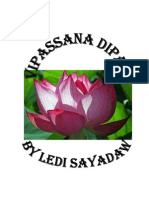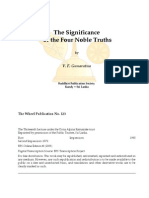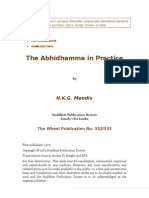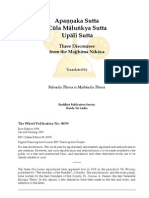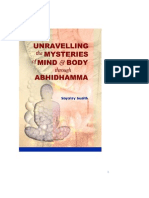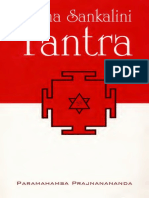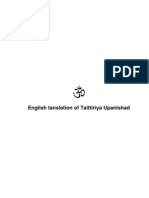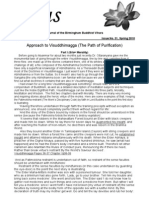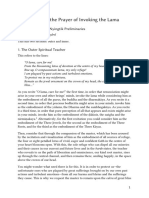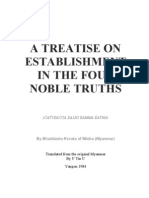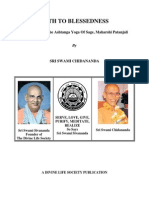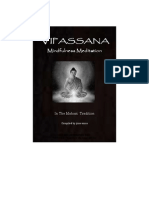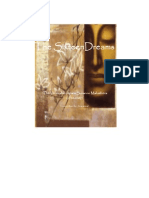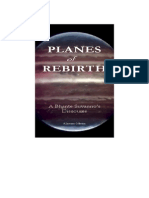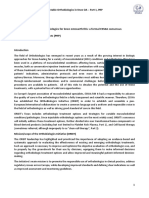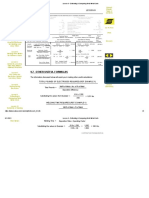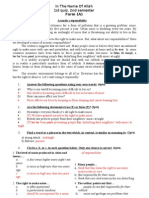0 ratings0% found this document useful (0 votes)
136 viewsMMilanda Vol 2P Intro Draft 9
MMilanda Vol 2P Intro Draft 9
Uploaded by
yokkee leongThis document provides an introduction to the Milindapañha, also known as The Questions of King Milinda. It discusses the publication of the text by the Myanmar-Singapore-Malaysia Dhamma Publication Society in 2014. The introduction notes that the text contains dialogues between the Buddhist monk Nagasena and the Greek king Menander I of India on various philosophical points. It also contains brief summaries of the contents of each division and chapter of the two-volume text.
Copyright:
© All Rights Reserved
Available Formats
Download as PDF, TXT or read online from Scribd
MMilanda Vol 2P Intro Draft 9
MMilanda Vol 2P Intro Draft 9
Uploaded by
yokkee leong0 ratings0% found this document useful (0 votes)
136 views19 pagesThis document provides an introduction to the Milindapañha, also known as The Questions of King Milinda. It discusses the publication of the text by the Myanmar-Singapore-Malaysia Dhamma Publication Society in 2014. The introduction notes that the text contains dialogues between the Buddhist monk Nagasena and the Greek king Menander I of India on various philosophical points. It also contains brief summaries of the contents of each division and chapter of the two-volume text.
Original Description:
Questions of King Milanda Vol.2
Copyright
© © All Rights Reserved
Available Formats
PDF, TXT or read online from Scribd
Share this document
Did you find this document useful?
Is this content inappropriate?
This document provides an introduction to the Milindapañha, also known as The Questions of King Milinda. It discusses the publication of the text by the Myanmar-Singapore-Malaysia Dhamma Publication Society in 2014. The introduction notes that the text contains dialogues between the Buddhist monk Nagasena and the Greek king Menander I of India on various philosophical points. It also contains brief summaries of the contents of each division and chapter of the two-volume text.
Copyright:
© All Rights Reserved
Available Formats
Download as PDF, TXT or read online from Scribd
Download as pdf or txt
0 ratings0% found this document useful (0 votes)
136 views19 pagesMMilanda Vol 2P Intro Draft 9
MMilanda Vol 2P Intro Draft 9
Uploaded by
yokkee leongThis document provides an introduction to the Milindapañha, also known as The Questions of King Milinda. It discusses the publication of the text by the Myanmar-Singapore-Malaysia Dhamma Publication Society in 2014. The introduction notes that the text contains dialogues between the Buddhist monk Nagasena and the Greek king Menander I of India on various philosophical points. It also contains brief summaries of the contents of each division and chapter of the two-volume text.
Copyright:
© All Rights Reserved
Available Formats
Download as PDF, TXT or read online from Scribd
Download as pdf or txt
You are on page 1of 19
i
sabbadna dhammadna jinti
The gift of dhamma excels all gifts
Milindapaha Volume 1 & 2 Milindapaha Volume 1 & 2 Milindapaha Volume 1 & 2 Milindapaha Volume 1 & 2
The Questions of King Milinda
(A Book of the Khuddaka Nikya)
The contents of this book may be reproduced either in part or
whole for free distribution, with or without prior consent.
Published and distributed by:
Myanmar-Singapore-Malaysia (MSM) Dhamma Publication
Society (2014).
Private funding by Dhamma Farers in Myanmar, Singapore and
Malaysia.
Edited in Myanmar and Malaysia by:
Dr. Ashin Kumara,
Leong Yok Kee and Carol Law
email: yokkee122@gmail.com
email: punnika68@gmail.com
Book cover design and layout by:
joey.t graphics
www.joeytgraphics.com
This edition May 2014 1,000 sets of 2 volumes
Printed and bound in Kuala Lumpur, Malaysia by:
Majujaya Indah Sdn. Bhd.
Tel: +603-4291 6001, +603-4291 6002
Fax: +603-4292 2053
ii
n nn namo tassa bhagavato arahato samm amo tassa bhagavato arahato samm amo tassa bhagavato arahato samm amo tassa bhagavato arahato samm sambudd sambudd sambudd sambuddhassa hassa hassa hassa
Veneration to the Exalted One, the H Veneration to the Exalted One, the H Veneration to the Exalted One, the H Veneration to the Exalted One, the Homage omage omage omage- -- -worthy O worthy O worthy O worthy One, ne, ne, ne,
t tt the Perfectly he Perfectly he Perfectly he Perfectly S SS Self elf elf elf- -- -enlightened O enlightened O enlightened O enlightened One ne ne ne
The Buddha is Supreme.
He is an Arahant, worthy of the highest veneration.
He has extinguished all defilements;
He is perfectly self-enlightened through
realisation of the Four Ariya Truths;
He is endowed with the six great qualities of glory:
issariya, dhamma,
yasa, sir,
kma and payatta.
Brahms, devas and all beings venerate the Buddha.
iii
MAIN MAIN MAIN MAIN CONTENT CONTENT CONTENT CONTENTS SS S
Publishers Introduction v
Prefatory Note xi
Publishers Editorial Note xiii
Introduction by Dr. Ashin Kumara xv
Previous Works on the Subject xviii
Volume I Volume I Volume I Volume I
Preamble 3
Division I: Division I: Division I: Division I: bhirakath bhirakath bhirakath bhirakath - -- - Background history Background history Background history Background history 7
pubbayogdi - Connections in the past 8
Division II: Division II: Division II: Division II: 38
Chapter 1: mahvagga - The great chapter 39
Chapter 2: addhnavagga - The long journey 70
Chapter 3: vicravagga - Discursive thoughts 89
Division III: Division III: Division III: Division III: 114
Chapter 4: nibbnavagga - The deathless realm 115
Chapter 5: buddhavagga - Pertaining to the Buddha 128
Chapter 6: sativagga - On mindfulness 136
Chapter 7: ar|padhammavavatthnavagga-
On mental phenomena 146
milindapahapucchvisajjan -
Questions of King Milinda and answers thereof 165
Division IV: Division IV: Division IV: Division IV: meakapaha meakapaha meakapaha meakapaha - -- - Question on dilemmas Question on dilemmas Question on dilemmas Question on dilemmas 168
Chapter 1: iddhibalavagga - Spiritual and
supernatural powers 180
Chapter 2: abhejjavagga - On schism 250
Chapter 3: pamitavagga - On bowing 276
Chapter 4: sabbautaavagga - On omniscience 307
Chapter 5: santhavavagga - On companionship 341
iv
Volume II Volume II Volume II Volume II
Division Division Division Division V: anumnapaha V: anumnapaha V: anumnapaha V: anumnapaha - -- - Questions on inference Questions on inference Questions on inference Questions on inference
Chapter 1: buddhavagga - The Buddhas 4
Chapter 2: nippapacavagga - Dhamma that thwarts
the cycle of birth and death 38
Chapter 3: vessantaravagga - King Vessantara 59
Chapter 4: anumnavagga - Inference 122
Division Division Division Division VI: opammakathpaha VI: opammakathpaha VI: opammakathpaha VI: opammakathpaha - -- - The similes The similes The similes The similes 170
mtik 171
Chapter 1: gadrabhavaggam - The ass 175
Chapter 2: samuddavagga - The ocean 191
Chapter 3: pathavvagga - The earth 206
Chapter 4: upacikvagga - The white ant 227
Chapter 5: shavagga - The lion 243
Chapter 6: makkaakavagga - The spider 257
Chapter 7: kumbhavagga - The water-pot 274
Epilogue Epilogue Epilogue Epilogue 285
v
Publishers Introduction Publishers Introduction Publishers Introduction Publishers Introduction
The triumvirate jewel of the Buddhas dhamma is given the
honorific title - Tipiaka, a Pi word meaning three baskets; ti
for three and piaka for basket. The tipiaka is the bulwark that
anchors the Buddhas dhamma; and the fortress within which the
dhamma flowers and brings forth fragrance of the truth to the
world at large. The tipiaka is the ssana; the tipiaka is the icon
of the ssana.
The tipiaka stands enduring and dynamic encompassed by its
three wise guardians: the Vinaya, the Suttanta and the
Abhidhamma. These three are the thrust and the defensive entity
beginning life with the first discourse at the deer park in Isipatana
when the Buddha began turning the wheel of dhamma for the
benefit of the five ascetics and a myriad of brahm, devas and
host of unseen beings. The tipiaka began to build up strength and
substance as the days and months go by. The rules of conduct for
bhikkh| was added on as and when the need arose and finally the
Abhidhamma was expounded in the heavenly realm. Thus was the
tipiaka honed and matured into the enduring triumvirate jewel -
the Triple Gem, which the Buddhas dhamma matured into in the
45 years of the Blessed One bringing the dhamma to an
unenlightened world of distorted conceptions not prepared to
recognise the Truth of its existence.
The Blessed One Himself realised this great failing of ordinary
worldlings when contemplating on His Enlightenment:
But the dhamma that I have realised is indeed profound, subtle
and difficult to comprehend. All beings in the world will not be
able to understand the dhamma as they are grossly overwhelmed
by greed, anger and ignorance. It will be wearisome for me if I
were to expound the dhamma. Reflecting thus, the Buddha was
hesitant to teach the dhamma.
vi
The quintessence of the Vinaya has the disciplinary rules of the
bhikkh| to ensure the proper morality of the sagha, and the
welfare of the bhikkh|.
The quintessence of the Abhidhamma has the 7 books of antiquity
for the education of those ready to accept the supramundane
words of the Buddha.
That leaves the Suttanta which is the variegated structure of the
words of the Buddha that was daily discoursed to all and sundry,
ordained and laity, who were then ready to receive and practise
the Truth.
The Pi term sutta means a thread, a string or a discourse; the
Buddhas discourses form a huge quilted tapestry of sutta. The
dhamma message is weaved strand by strand, thread by thread
onto the multi-weaved fabric that stands as a complete edifice; a
network that inclines and tapers into freedom from suffering,
never to find rebirth into another existence whatsoever.
To gain this total freedom from suffering or in Pi, dukkha,
academic studies and absorption of knowledge into the fibres of
our mental potentialities is insufficient effort. In the long term,
this insufficiency of effort will degenerate into wrong effort. Too
much energy expanded into pure academic studies will engender a
sense of superiority in the individual and retards the development
of wisdom.
The Buddha in His great wisdom and knowledge has not only
given us the basis to understand and realise the inherent failings
in us, but also the means to apply one, sole physical practice to
attain to the state wherein we will surely remove all defilement
from our kamma and escape the round of rebirth in totality.
vii
ekyano aya, bhikkhave, maggo sattna visuddhiy
sokapariddavna samatikkamya dukkhadomanassna
attha~gamya yassa adhigamya nibbnassa sacchikiriyya,
yadida cattro satipahna.
This is the only way, bhikkh|, for the purification of beings, for
the overcoming of sorrow and lamentation, for the disappearance
of pain and grief, for reaching the noble path, for the realisation
of nibbna, namely: the four foundations of mindfulness.
The knowledge embedded within the expansive stratospheric
reach of the tipiaka is beyond conceptual realisation. The best
illustration to expound the borderless jurisdiction of the tipiaka is
in the simile of the leaves of the trees in the forest.
A Handful of Leaves A Handful of Leaves A Handful of Leaves A Handful of Leaves
The Blessed One was once living at Kosambi in a wood of
Sisap trees. He picked up a few leaves in his hand, and
questioned the bhikkh|: How do you conceive this, bhikkh|,
which is more, the few leaves that I have picked up in my hand or
those on the trees in the wood?
The leaves that the Blessed One has picked up in His hand are
few, Lord; those in the wood are far more.
So too, bhikkh|, the things that I have known by direct
knowledge are more; the things that I have told you are only a
few. Why have I not told them? Because they bring no benefit, no
advancement in the Holy Life, and because they do not lead to
dispassion, to fading, to ceasing, to stilling, to direct knowledge,
to enlightenment, to nibbna. That is why I have not told them.
viii
And what have I told you? This is suffering; this is the origin of
suffering; this is the cessation of suffering; this is the way leading
to the cessation of suffering. That is what I have told you. Why
have I told it? Because it brings benefit, and advancement in the
Holy Life, and because it leads to dispassion, to fading, to
ceasing, to stilling, to direct knowledge, to enlightenment, to
nibbna. So bhikkh|, let your task be this: this is suffering; this is
the origin of suffering; this is the cessation of suffering; this is
the way leading to the cessation of suffering.
(Sayutta Nikya, 56:31)
To gain good results from any form of activities, be it education,
the sports, the arts, philosophies, spiritual studies, even skills such
as cooking, wood-work, metal work, silver work, gold craft, etc.,
one needs a suitable medium or base to work from, a platform to
operate from.
The platform from which the multi-faceted knowledge of the
tipiaka can be garnered is the four foundations of mindfulness -
satipahna.
The goad, the springboard, the catalyst, the platform, the carriage,
etc., for the realisation of the knowledge from the tipiaka is an
experiential training in the form of the practice of satipahna.
Make no mistake, though, the way of satipahna is not an easy
way! But it is the Only way for the overcoming of sorrow and
lamentation, for the disappearance of pain and grief, for reaching
the noble path, for the realisation of nibbna.
The Blessed One in most cases when He dismisses listeners at the
end of any discourse, be they ordained or lay, admonishes thus:
These are the roots of trees, bhikkh|, these are empty huts,
meditate, do not be negligent; lest you regret it later.
ix
The final goal of the practice of satipahna is the attainment of
enlightenment and the usual statement to indicate that a
practitioner has achieved that freedom is stated as: obtained the
pure and spotless eye of the truth (that is, the knowledge).
Whatsoever is subject to the condition of origination is subject
also to the condition of cessation.
The study of the questions of King Milinda cannot stand alone as
a complete knowledge ending the quest for the realisation of the
dhamma. It is only one well-oiled cog amongst all the different
parts and parcels that make up the wheel of dhamma; just as the
chariot has its parts and a living being has its aggregates, so the
dhamma, too, has a myriad of sutta: long ones, medium lengths
and minor ones to complete the whole.
In the midst of a persons journey towards the dhamma most
desired fruit, it is imperative that he must face up to the trials and
teachings in the satipahna; failing which his attainment of any
dhamma knowledge will backslide and be reduced to zero.
To be able to begin our investigation of the Buddhas dhamma
with the Milindapaha is the correct and meritorious step towards
the goal of emancipation; for within its pages are the gems and
jewels that will lead the dhamma seeker onwards to the
enlightened purity of nibbna.
The consequential path from this will be the sole diligent practice
of satipahna, leaving all others behind. This will enhance the
seekers knowledge and wisdom, thereby eradicating his
ignorance and developing his insight leading onto the
supramundane knowledge essential for the attainment of
cessation.
x
Most seekers are content and feel gratified that they have in their
portfolio of dhamma studies all the necessary academic literature,
including the nikya and even the Milindapaha! Not to seek and
experience the correct practice is akin to doing things half way;
just as water cannot boil if the power is switch off half way or
rice cannot be eaten if not cooked to its maximum for the
goodness to surface. Academic quests are just that, it is the
acquisition of mundane knowledge. To realise the reality of the
Buddhas dhamma, one needs to go the extra mile; that extra mile
in the case of the dhamma is the supramundane experience.
A dictionary has all the words necessary for you to write a book,
the dictionary cannot write a book; you have to know the words
from the dictionary and then you can string those words into lines
of sentences. The dictionary teaches you the words, you apply the
words to bring out the whole book! Just so, the Buddhas words
are to give you knowledge, you have to string those knowledge
together to find the path that will lead you to supramundane
experiences; and the tool to string the Buddhas words together is
the practice of satipahna.
As the Buddha exhorts, we too exhort; there are trees and
secluded places, dear friends, practise vipassan meditation, do
not neglect, lest you end up in undesirable realms.
Dr. Ashin Kumara
Leong Yok Kee
Carol Law Mi-Lan
xi
Prefatory Note Prefatory Note Prefatory Note Prefatory Note
The Milindapaha in the Theravda tradition, is regarded highly
as a book of authority and has long been a popular piece of
literature in the Pi form; and at the Chahasa~gti Pitaka (the
Sixth Buddhist Council) held in Yangon, 1954, the Milindapaha
was formally included as the 18
th
book in a list of 18 books in the
Khuddaka Nikya according to the Burmese tradition.
The Milindapaha seek to introduce and at the same time clarify
fundamental points in the Teaching of the Buddha. It does so in a
simple question and answer dialogue between two highly placed
personality so that it has the authority of royalty in the
questioning and a very knowledgeable arahant in the clear
answers. The raison detre of the dialogue is clear; royalty to
commoner will benefit from the dhamma! Thus, the questioner
was a Greek king; King Menander or Milinda and the answers
presented by the bhikkhu, Ngasena, an arahant.
The questions brought to our attention by the king and the
solutions discussed and offered by the arahant Ngasena pinpoint
the basic tenets which form the cornerstone of the Buddhas
sublime Teaching.
The succinct and factual answers presented by the arahant
Ngasena, in most cases complemented by similes and examples,
eloquently propounded and in an easy grace of dialogue, mostly,
though not always, truly appeals to the discerning seeker of the
Buddhas dhamma.
There were occasions when Ngasena, not too happy with the
quality of questions raised by the king, replied testily.
xii
It is no doubt that it is the charm of this style and the profound
nature of the answers that has drawn many to see in the
Milindapaha, an all-encompassing showcase of the Buddhas
Teaching, in a nutshell as it were.
May the transcendent Teaching of the Blessed One that is
available to us today, enrich and enlighten those who continue to
investigate and practise the dhamma.
Carol Law
xiii
Publisher Publisher Publisher Publishers ss s Editorial Not Editorial Not Editorial Not Editorial Notes es es es
The first known English translation of the Milindapaha was
possibly one done by T.W. Rhys Davids, published about 120
years ago. There is no doubt how popular and widely sought after
the Milindapaha is, judging by its translations available today in
English, French, German, Russian, Burmese, Chinese, Japanese,
Hindi, Sinhalese, Sanskrit and so forth.
In our preparation of this set of two volumes, we were privileged
to have in our hands a copy of the English translation from the
Pi and Burmese versions, as well as many books that form the
basis of our reference and research.
The style adopted in this classic prose is essentially that of a
dialogue between two people: King Milinda and the Venerable
Ngasena. We have thus used abbreviations to indicate the direct
speeches of these two people km km km km for King Milinda and vn vn vn vn for
Venerable Ngasena. We believe this makes for an easier and a
more enjoyable read.
In attempting to keep to the proper presentation of the words in
the Pi form, these terms are written with small letters, as in the
tradition of the language. Capital letters are not used for Pi
words even when it is the start of a sentence. The exception is
made for proper nouns to distinguish them as terms used with
reference to the Buddha and names of people and places.
As the illustrious conversations between the king and the
venerable ran well over 700 pages, we thought it best that the
book be presented in two volumes. Volume I houses divisions I to
IV while Volume II concludes the rest of the discussion with
divisions V and VI.
xiv
In this way, the readers hands are not strained with cradling a
massive book, or the shoulders burdened with the extra weight
should he wish to bring it around with him. Of course, to match
the respect and prestige the Milindapaha holds, the two volumes
are presented to you, encased in an elegant magnetic box jacket,
specially designed to keep the books together.
In the rendition of a somewhat lengthy text, readers may find
themselves lost in the labyrinth of topics and dilemmas covered
therein. By introducing a detailed sub-content page at the start of
each chapter, our goal is to put in better perspective, the main
sections from the sub-sections. Hopefully our reader will find this
a useful as well as an effective tool as they navigate through the
eclectic book.
In closing, the editors would like to put on record, their expressed
gratitude in being called to such a noble and onerous undertaking.
It is their wish that in their humble endeavour to refine the
presentation of this essential dhamma literature so that many
more will glean from it the goodness of the profound Teaching of
the Buddha within. May the ssana endure, may the pristine
dhamma prevail.
Dr. Ashin Kumara
Leong Yok Kee
Carol Law
xv
Introd Introd Introd Introduction uction uction uction by by by by Dr. Ashin Kumara Dr. Ashin Kumara Dr. Ashin Kumara Dr. Ashin Kumara
Siddhattha Gotama was born in 623 B.C., renounced family life,
the life of a prince at the prime of a youths life, 29 years of age.
He renounced the luxurious life of royalty and donning the cast-
off robes befitting a homeless renunciate; deeply aware of the
sorrows of existence in a world led by mindless desires; with firm
steps and purposeful determination, he went in search of the
Truth. Through 6 years of life and death struggles, nearing death
more than not, He achieved the Supreme state of Buddhahood at
the age of 35 and attained parinibbna at the age of 80 (543 B.C.).
For 45 years after attaining Buddhahood, He steadfastly, without
a care for His own comfort, toured the country, especially the
North-eastern part of India, expounding the sutta, abhidhamma
and the vinaya to gods and men.
The principles, laws and disciplines for monastic life are
enshrined in the Vinaya Disciplinary Rules; Sutta form the basis
for daily practice and the Abhidhamma holds the knowledge of
the Buddhas philosophy and psychology.
Long after the Buddha attained parinibbna, the vinaya rules, the
dhamma in the form of sutta and abhidhamma still exist as a
teacher for a wholesome and moralistic life. As long as they still
exist, we can be sure that we still have the Buddha in our midst.
The Buddha taught the dhamma to all, regardless of gender, age
or stations in life, so that the truth of their existence will be
understood by them. He also encouraged those who wish to take
up the Holy Life that they adhere to strict rules, so that they may
co-exist in harmony with other fellow human beings and practise
to gain penetrative wisdom into the knowledge of ultimate reality
as enshrined in the tipiaka.
xvi
The whole of the teachings of the Buddha are collectively known as
the Three Baskets or tipiaka. As such, the tipiaka has taken on
the essence of the Buddha Himself and now becomes our teacher
and mentor.
Three months after the Buddhas parinibbna, a Great Council of
the arahant theras was convened led by the Elder Mah Kassapa.
The Council held in Rjagaha was attended by 500 arahants. At
the conclusion of this lengthy Great Council, the arahant theras,
of whom the Elder Mah Kassapa was the leader, made three
irrevocable stipulations. That henceforth, the teachings of the
Buddha as confirmed in this Council, should be kept strictly to the
word, letter and intent.
Thus, there should be no addition to the words, no deletion and
the format presented here should remain as it is. Therefore, this
Council set the tone of the tradition that is kept intact until today.
This knowledge, belief and practice that are strictly in accordance
with the dhamma and vinaya of the Buddha are known as the
teachings of the elders or theravda dhamma and vinaya.
The Second Council, headed by Sabbakmi Thera and Yasa
Thera, was held in 100 B.E. (Buddhist Era) in Vesl and was
attended by 700 monks.
The Third Council headed by Tissa Thera took place in 236 B.E.
in Paaliputta and was attended by 1,000 monks. The First, Second
and Third Councils were the only councils held in India and all
the participants were arahants.
The Fourth Council led by the Venerable Dhammarakkhita,
attended by 500 Sri Lankan monks was held in Sri Lanka in 540
B.E. At this Council, the words of the tipiaka was engraved and
preserved onto palm leaves.
xvii
In 2400 B.E., the Fifth Council led by the Venerable Jgara Thera
and attended by 2,400 monks was held in Mandalay, Burma. At
this Council, the tipiaka was inscribed onto 729 marble slabs,
each measuring 6 feet by 4 feet. These can still be seen today at
the Maha Lokamarazein Kuthodaw Pagoda, Mandalay Hills.
The Sixth Council, sponsored by the Burmese Government, was
held in 2498 B.E (May, 1954) in Kaba-Aye, Yangon, Myanmar, at
the Mahpsna Great Cave (a duplicate of the original cave of
the First Council). The Council took two years to conclude its
mission. The unique feature of the Sixth Council was the
participation by learned monks from five Theravda and some
Mahyana countries.
Present day literature that attempts to explain the Buddhas
Teaching are merely the interpretation of various authors in their
limited knowledge and understanding of the true dhamma. They
act only as a secondary source of information to the profound
Teaching. For those who have not acquired the genuine essence
of the authentic and pristine Teaching of the Buddha from true
sources and not knowing the true dhamma is indeed, a great loss
to them.
May the knowledge, belief and practice of the Truth shine forth
in every corner of our world.
Dr. Ashin Kumara
xviii
Previous Previous Previous Previous W WW Works on the orks on the orks on the orks on the S SS Subject ubject ubject ubject
The Pi Milindapaha and its Chinese counterpart, Na-hsien-pi-
ch'iu-ching have enjoyed much popularity among Western and
Eastern scholars, and numerous are the translations of the two
above texts into various languages. Some of these translations are
mentioned below:
1. Louis Finot: Les Questions de Milinda, Paris 1923 (French
translation of Books I-III).
2. T.W. Rhys Davids: The Questions of King Milinda (English
translation from the Pi, 1890)
3. Nynatiloka: Fragen des Milinda, Munchen 1919 (Complete
German translation).
4. F. Otto Schrader: Die Fragen des Konigo Menandros, Berlin
1905 (German translation of the portions held to be original
by the translator).
5. Specht and Levi: Deux traductions chinoises de
Milindapaho: Oriental Congress IX, London, 1892, Vol. I,
p.518ff.
6. Sogen Yamagami: Sutra on Questions of King Milinda
(Japanese translation from the Chinese text).
7. Sei Syu Kanamoli: Questions of King Milinda (Japanese
translation from the Pi text).
8. Paul Demieville: Les versions Chinoises du Milindapaha,
BEFEO, Vol. XXIV, 1924.
Dissertations on the two Pi and Chinese texts, and
comparative studies of them have captured the attention of
many learned pait. Some of these dissertations and
comparative studies are cited below:
1. Garbe: Beitrge zur indischen Kulturgeschichte Belin, 1903.
2. Mrs C.A.F. Rhys Davids: The Milinda Question, London
1930.
xix
3. T.W. Rhys Davids: Encyclopaedia of Religion and Ethics,
Vol. VIII, p.631ff., article on "Milindapaho"
4. Taisho edition of the Chinese Tripitaka edited by Takakusu
and Watanabe, Vol.32, No.1670 (a&b).
5. Winternitz: History of Indian Literature, Vol. II, pp.174-183.
6. Siegfried Behrsing, Beitrage zu einer, Milinda Bibliographie,
Bulletin of the School of Oriental Studies, Vol. VII, 3.
pp.516ff.
7. B. C. Law: A History of Pi Literature Vol. II, pp. 353-72.
8. J. Takakusu: Chinese Translations of the Milindapaha
JRAS, 1896.
9. Dr. Kogen Mizuno: On the Recensions of Milindapaho.
You might also like
- Joyful Path of Good Fortune ADocument326 pagesJoyful Path of Good Fortune ADavid JaimesNo ratings yet
- The Collected Works of ShinranDocument472 pagesThe Collected Works of ShinranAlexandros Pefanis100% (1)
- Stilling the Mind: Shamatha Teachings from Dudjom Lingpa's Vajra EssenceFrom EverandStilling the Mind: Shamatha Teachings from Dudjom Lingpa's Vajra EssenceRating: 5 out of 5 stars5/5 (2)
- The Chakrasamvara Root Tantra: The Speech of Glorious HerukaFrom EverandThe Chakrasamvara Root Tantra: The Speech of Glorious HerukaRating: 4 out of 5 stars4/5 (1)
- Core Teachings of Kagyu School MahamudraDocument10 pagesCore Teachings of Kagyu School MahamudraGediminas GiedraitisNo ratings yet
- Mindfulness, Bliss, and Beyond: A Meditator's HandbookFrom EverandMindfulness, Bliss, and Beyond: A Meditator's HandbookRating: 4 out of 5 stars4/5 (26)
- The Way of Buddhist MeditationDocument82 pagesThe Way of Buddhist Meditationpatxil100% (1)
- Milindapanha Vol.1Document372 pagesMilindapanha Vol.1yokkee leongNo ratings yet
- Milindapanha Vol.1Document372 pagesMilindapanha Vol.1yokkee leongNo ratings yet
- Vipassana Dipani (By Ledi Sayadaw)Document44 pagesVipassana Dipani (By Ledi Sayadaw)api-3728716No ratings yet
- 04 Anapanasati Sutta PDFDocument11 pages04 Anapanasati Sutta PDFmarcos.peixotoNo ratings yet
- Significance of Four Noble TruthsDocument22 pagesSignificance of Four Noble TruthsBuddhist Publication SocietyNo ratings yet
- Vipassana-Dipani - Mahathera Ledi SayadawDocument75 pagesVipassana-Dipani - Mahathera Ledi SayadawJack FooNo ratings yet
- Acharya Suvanno Mahathera - Dhamma Rediscovered PDFDocument185 pagesAcharya Suvanno Mahathera - Dhamma Rediscovered PDFMario Galle MNo ratings yet
- The Abhidhamma in Practice - N.K.G. MendisDocument54 pagesThe Abhidhamma in Practice - N.K.G. MendisDhamma Thought100% (2)
- Exegetical 8Document5 pagesExegetical 8Fussa DhazaNo ratings yet
- 17 Neo Vedanta PB S Atmapriyananda ADocument7 pages17 Neo Vedanta PB S Atmapriyananda Adeepakh sharmaNo ratings yet
- MP Book 2 Draft 9Document289 pagesMP Book 2 Draft 9yokkee leongNo ratings yet
- Religious Experience On Buddhism BarnesDocument11 pagesReligious Experience On Buddhism BarnesBharat DevanaNo ratings yet
- The Word Of The Buddha; An Outline Of The Ethico-Philosophical System Of The Buddha In The Words Of The Pali Canon, Together With Explanatory NotesFrom EverandThe Word Of The Buddha; An Outline Of The Ethico-Philosophical System Of The Buddha In The Words Of The Pali Canon, Together With Explanatory NotesRating: 4 out of 5 stars4/5 (1)
- Homage To The 28 BuddhasDocument42 pagesHomage To The 28 BuddhasSujeewa Gunasinghe100% (1)
- Kapila Dev Glories - HVDDocument8 pagesKapila Dev Glories - HVDmaverick6912No ratings yet
- An Overview of The Triple VisionDocument32 pagesAn Overview of The Triple Visionthinh.academiavnNo ratings yet
- Apannaka Sutta, Cula Malunkya Sutta, Upali SuttaDocument37 pagesApannaka Sutta, Cula Malunkya Sutta, Upali SuttaBuddhist Publication Society100% (1)
- Unravelling The Mysteries of Mind and Body Through AbhidhammaDocument157 pagesUnravelling The Mysteries of Mind and Body Through AbhidhammaTanvir100% (3)
- Vipassana DipaniDocument42 pagesVipassana DipaniTisarana ViharaNo ratings yet
- BM#6 Not Only SufferingDocument58 pagesBM#6 Not Only SufferingBGF100% (1)
- 4 Noble TruthsDocument70 pages4 Noble TruthsDarnellNo ratings yet
- Buddhist Meditation and Its Forty SubjectsDocument28 pagesBuddhist Meditation and Its Forty SubjectsQiyun WangNo ratings yet
- Awakening Wisdom: Heart Advice on the Fundamental Practices of Vajrayana BuddhismFrom EverandAwakening Wisdom: Heart Advice on the Fundamental Practices of Vajrayana BuddhismNo ratings yet
- Dharma EssentialDocument29 pagesDharma EssentialBai HenryNo ratings yet
- The Smokeless Fire: Unravelling The Secrets Of Isha, Kena & Katha UpanishadsFrom EverandThe Smokeless Fire: Unravelling The Secrets Of Isha, Kena & Katha UpanishadsNo ratings yet
- The Wheel of Birth and DeathDocument33 pagesThe Wheel of Birth and DeathabrahamzapruderNo ratings yet
- Jnana Sankalini Tantra Paramahansa Prajnanananda - TextDocument251 pagesJnana Sankalini Tantra Paramahansa Prajnanananda - TextAnonymous Mkk75e100% (6)
- Summary of Vol. VIII of Abhinavagupta's Sri Tantraloka and Other WorksDocument5 pagesSummary of Vol. VIII of Abhinavagupta's Sri Tantraloka and Other WorksMukesh100% (1)
- Sects Sectarianism Bhikkhu Sujato PDFDocument176 pagesSects Sectarianism Bhikkhu Sujato PDFAndrew SwayNo ratings yet
- English Tanslation of Taittiriya UpanishadDocument14 pagesEnglish Tanslation of Taittiriya UpanishadNavin PatelNo ratings yet
- Buddhist MeditationDocument28 pagesBuddhist MeditationLockeNguyenNo ratings yet
- 1 - Bhakti - Sastri - Intro - Suhotra Maharaja The Printed VersionDocument12 pages1 - Bhakti - Sastri - Intro - Suhotra Maharaja The Printed VersionDevotionalMellowsNo ratings yet
- BuddhismDocument38 pagesBuddhismaclanasuncionNo ratings yet
- The Heart Sutra Loosening The Grip of Ego GraspingDocument64 pagesThe Heart Sutra Loosening The Grip of Ego GraspingbuntyurawgamerNo ratings yet
- Sarva Gita Sara 2012 Edition by Swami SivanandaDocument272 pagesSarva Gita Sara 2012 Edition by Swami Sivanandakartikscribd100% (10)
- Gateway To Krishna Consciousness Student Handbook Part OneDocument63 pagesGateway To Krishna Consciousness Student Handbook Part OneOnisha DuaNo ratings yet
- IXchap BCA CommentDocument37 pagesIXchap BCA CommentscimmiasapiensNo ratings yet
- Journal of The Buddhist ViharaDocument8 pagesJournal of The Buddhist Viharaccol777No ratings yet
- Kurukulla Meditation A5Document16 pagesKurukulla Meditation A5Jim LeeNo ratings yet
- Unraveling The Mysteries of Mind-Body Through Abhidhamma by Sayalay SusilaDocument175 pagesUnraveling The Mysteries of Mind-Body Through Abhidhamma by Sayalay SusilaCharlieCTNo ratings yet
- Invoking The LamaDocument4 pagesInvoking The LamaAndre HscNo ratings yet
- A Pictorial Manual For Meditators: Achan Sobin S. NamtoDocument83 pagesA Pictorial Manual For Meditators: Achan Sobin S. Namtofrances_meng4058No ratings yet
- A History of MindfulnessDocument396 pagesA History of MindfulnessNuno CastroNo ratings yet
- U Ko Kay - Manual of Vipassana Meditation-Vipassana Research InstituteDocument132 pagesU Ko Kay - Manual of Vipassana Meditation-Vipassana Research InstituteCaoNo ratings yet
- KundaliniDocument294 pagesKundaliniReeshabhdev Gauttam0% (1)
- Theravada-WPS OfficemyraDocument49 pagesTheravada-WPS OfficemyraMyra Jane GeonsonNo ratings yet
- Coping With A Handful of LeavesDocument21 pagesCoping With A Handful of LeavesKamal RajharshaNo ratings yet
- A Lamp Illuminating The Path To Liberation 2nd EdDocument268 pagesA Lamp Illuminating The Path To Liberation 2nd EdShashi Nair100% (1)
- A Treatise On Establishment in The Four Noble TruthsDocument330 pagesA Treatise On Establishment in The Four Noble Truthsdhamadarna100% (1)
- Path To BlessednessDocument71 pagesPath To BlessednessSex Free LifeNo ratings yet
- Mind of Mahamudra: Advice from the Kagyu MastersFrom EverandMind of Mahamudra: Advice from the Kagyu MastersNo ratings yet
- Enlightenment to Go: Shantideva and the Power of Compassion to Transform Your LifeFrom EverandEnlightenment to Go: Shantideva and the Power of Compassion to Transform Your LifeRating: 4 out of 5 stars4/5 (5)
- MP Book 2 Draft 9Document289 pagesMP Book 2 Draft 9yokkee leongNo ratings yet
- Acharya Suvanno Mahathera - Dhamma Rediscovered PDFDocument185 pagesAcharya Suvanno Mahathera - Dhamma Rediscovered PDFMario Galle MNo ratings yet
- MP Book 2 Draft 9Document289 pagesMP Book 2 Draft 9yokkee leongNo ratings yet
- Vipassana Mindfulness MeditationDocument157 pagesVipassana Mindfulness Meditationyokkee leong100% (8)
- Thoughts On The DhammaDocument35 pagesThoughts On The Dhammakosta22No ratings yet
- Window To The SuttasDocument193 pagesWindow To The Suttasyokkee leong100% (1)
- Striving To Be A NobodyDocument172 pagesStriving To Be A Nobodyyokkee leong75% (4)
- The Sixteen Dreams 2Document120 pagesThe Sixteen Dreams 2yokkee leongNo ratings yet
- Samatha Vipassana YuganaddhaDocument211 pagesSamatha Vipassana Yuganaddhayokkee leongNo ratings yet
- Acharya Suvanno Mahathera - Dhamma Rediscovered PDFDocument185 pagesAcharya Suvanno Mahathera - Dhamma Rediscovered PDFMario Galle MNo ratings yet
- Planes of RebirthDocument104 pagesPlanes of Rebirthyokkee leong100% (1)
- Arousing of InsightDocument120 pagesArousing of Insightyokkee leong100% (2)
- Practical Notebook 8 Semester2Document75 pagesPractical Notebook 8 Semester2rabby420plusNo ratings yet
- Year 9 Surds ExamDocument2 pagesYear 9 Surds Examsaavir.aryaNo ratings yet
- Anexo 3 Consenso de La Eskka en OsteoartritisDocument58 pagesAnexo 3 Consenso de La Eskka en OsteoartritisgrimmNo ratings yet
- Botany Multiple Choice QuestionsDocument7 pagesBotany Multiple Choice QuestionsAsnad KoppathNo ratings yet
- KatalonDocument32 pagesKatalonMaheshNo ratings yet
- BP Recweek Final Na TalagaDocument10 pagesBP Recweek Final Na TalagaChin RamosNo ratings yet
- WHO Growth Chart Boy - Draft 01 - 1425701689Document54 pagesWHO Growth Chart Boy - Draft 01 - 1425701689silentnewbie100% (1)
- Earthquake HazardsDocument20 pagesEarthquake HazardsJOHN REY ARIOLA100% (1)
- Shade CardDocument8 pagesShade CardRana GabrNo ratings yet
- Kaapi Master - Kufico Work From Home Franchise KitDocument4 pagesKaapi Master - Kufico Work From Home Franchise KitkumbakonamfiltercoffeeNo ratings yet
- فسلجة دم الطيورDocument604 pagesفسلجة دم الطيورMustafa AL-Asadsy100% (1)
- Muhammad Aslam Dena Nath Bhai Pheru: Web Generated BillDocument1 pageMuhammad Aslam Dena Nath Bhai Pheru: Web Generated BillWaqas MunirNo ratings yet
- Umc-750 MLD 11 2022Document11 pagesUmc-750 MLD 11 2022Luận LêNo ratings yet
- Latch Kit CrosbyDocument1 pageLatch Kit CrosbyRodolfo Garduño ColínNo ratings yet
- Geogrid Standard Material SpecificationDocument2 pagesGeogrid Standard Material SpecificationBriccioNo ratings yet
- Tabla Tubos HNDocument4 pagesTabla Tubos HNJuan Carlos MendezNo ratings yet
- The Quantum Mechanical Atom: Chemistry: The Molecular Nature of Matter, 6EDocument118 pagesThe Quantum Mechanical Atom: Chemistry: The Molecular Nature of Matter, 6Eamel andiniNo ratings yet
- Super Adobe ConstructionDocument3 pagesSuper Adobe ConstructionGilles GautierNo ratings yet
- Draft 001 001Document31 pagesDraft 001 001amanda05700No ratings yet
- Fabrication and Mechanical Behaviors of An All-Composite Sandwich Structure With A Hexagon Honeycomb Core Based On The Tailor-Folding ApproachDocument23 pagesFabrication and Mechanical Behaviors of An All-Composite Sandwich Structure With A Hexagon Honeycomb Core Based On The Tailor-Folding ApproachfredNo ratings yet
- Oisd STD 244-Draft - III 1Document119 pagesOisd STD 244-Draft - III 1akhilendraa6221No ratings yet
- File For Parts Bricks Lining Machine and UT PumopDocument7 pagesFile For Parts Bricks Lining Machine and UT Pumopranjan shiveshNo ratings yet
- Conveyor ExDocument1 pageConveyor Extdkhiem02No ratings yet
- Current Affairs ENGLISH, Month of JULY' 2023 With Cover PageDocument38 pagesCurrent Affairs ENGLISH, Month of JULY' 2023 With Cover Pagenidhi017llmNo ratings yet
- Full Length Test Part 2Document4 pagesFull Length Test Part 2Priyanka DubeyNo ratings yet
- SSRPL PRECAST - Quality ManualDocument38 pagesSSRPL PRECAST - Quality Manualshankarnarayanan525No ratings yet
- Lesson 9 - Estimating & Comparing Weld Metal CostsDocument2 pagesLesson 9 - Estimating & Comparing Weld Metal CostsDhanus KodiNo ratings yet
- Answer - Text - (Acoustic Responsibility)Document2 pagesAnswer - Text - (Acoustic Responsibility)Mohamed HADDATNo ratings yet
- 02 JSA S-808 Rev 01Document11 pages02 JSA S-808 Rev 01Mohd KhaidirNo ratings yet
- Neck and Head MassesDocument13 pagesNeck and Head MassesGhaiidaa khhNo ratings yet








